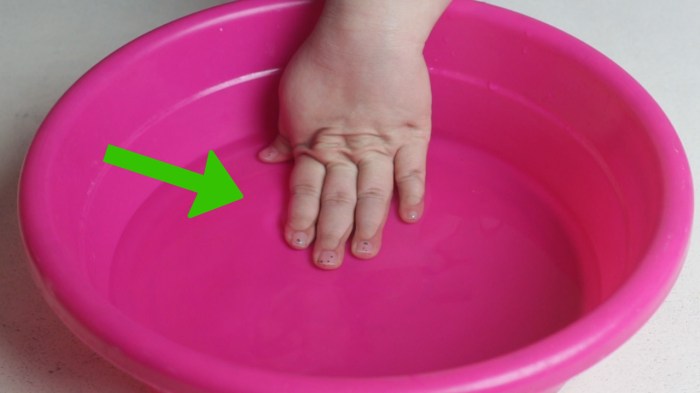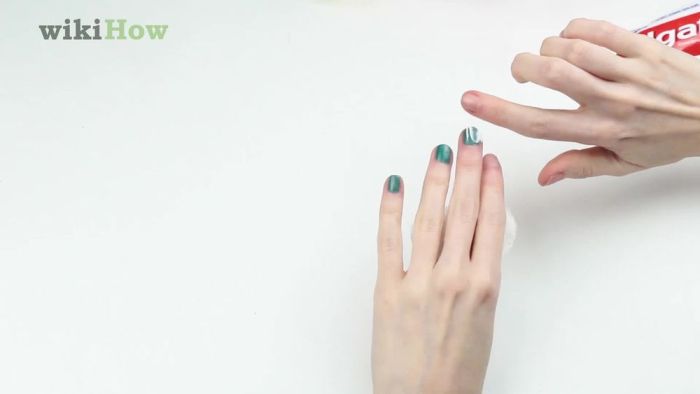Get Nail Polish Off Without Remover
Removing Nail Polish Without Remover: Household Methods
Get nail polish off without remover – Removing nail polish without commercial remover is possible using common household items. These methods vary in effectiveness and may require more time and effort than using traditional polish remover, but they offer a viable alternative for those seeking a remover-free approach. This section explores several household methods, detailing their processes and potential drawbacks.
Toothpaste for Nail Polish Removal, Get nail polish off without remover

Source: rvohealth.io
The abrasive nature of toothpaste, particularly whitening varieties, can help gently lift nail polish. However, effectiveness varies depending on the polish type and the toothpaste’s texture. For best results, use a non-gel toothpaste with a slightly gritty consistency.
- Apply a small amount of toothpaste directly onto the nail polish.
- Gently rub the toothpaste onto the nail using a soft-bristled toothbrush or cotton swab in a circular motion.
- Continue rubbing for several minutes, adding more toothpaste as needed.
- Rinse the nail thoroughly with warm water and gently wipe away any remaining polish residue.
- Apply cuticle oil to moisturize and protect the nails.
Precautions: Avoid using abrasive toothpastes with harsh chemicals, as these could damage the nail surface. Test a small area first to check for any adverse reactions.
Comparison of Baking Soda & Lemon Juice vs. White Vinegar & Salt
Both baking soda and lemon juice, and white vinegar and salt offer alternative methods for nail polish removal. Their effectiveness varies based on the type of nail polish and the application technique. The following table compares the two methods:
| Method | Effectiveness | Time Required | Potential Drawbacks |
|---|---|---|---|
| Baking Soda & Lemon Juice | Moderate; works best on lighter colored polishes. | 15-20 minutes | Can be drying to the nails; may not remove stubborn or dark polishes effectively. |
| White Vinegar & Salt | Low; more effective as a pre-treatment to soften the polish before scrubbing. | 10-15 minutes (as a pre-treatment) | Strong smell; may irritate sensitive skin. |
Hand Soap and Warm Water for Nail Polish Removal
This method is best suited for removing very light or chipped nail polish, or as a supplementary method after pre-treating the nails with other techniques. A liquid hand soap with a slight abrasive quality will prove most effective.
- Wash your hands thoroughly with warm water and a liquid hand soap.
- Pay special attention to the nails, gently rubbing the soap onto the nail polish.
- Continue washing for at least 5 minutes, or longer if needed.
- Rinse your hands and nails thoroughly with warm water.
- Gently wipe away any remaining polish with a soft cloth or cotton swab.
This method is best used with a gentle, yet slightly abrasive soap. The warmth of the water helps soften the polish, making it easier to remove.
Rubbing Alcohol for Nail Polish Removal
Isopropyl alcohol (rubbing alcohol) can effectively remove nail polish, particularly lighter shades. The process involves applying the alcohol to a cotton ball or pad and gently rubbing it on the nail surface. The alcohol will dissolve the polish, leaving behind a clear nail. A 70% concentration of isopropyl alcohol is typically sufficient. The alcohol is a clear, colorless liquid with a slightly pungent odor.
Its texture is thin and watery.
- Pour a small amount of rubbing alcohol onto a cotton ball.
- Gently rub the cotton ball over the nail polish, working in one direction to avoid smudging.
- Repeat as needed until the polish is completely removed.
- Wash hands thoroughly with warm water and soap.
Acetone-Free Alternatives for Nail Polish Removal

Source: wikihow.com
Acetone-based removers are highly effective but can dry out and damage nails. Acetone-free alternatives provide a gentler approach to nail polish removal. This section explores various acetone-free options and their effectiveness.
Nail Polish Remover Wipes vs. Traditional Acetone-Based Removers
Nail polish remover wipes offer convenience and portability, but they may not be as effective as traditional acetone-based removers, especially for stubborn polishes. Traditional removers often provide better results but require more steps and may cause dryness.
Using Cuticle Oil for Gentle Nail Polish Removal
Cuticle oil, particularly those with nourishing ingredients like vitamin E, can be used to gently remove very light or chipped nail polish. It softens the polish, making it easier to wipe away.
- Apply a generous amount of cuticle oil to each nail.
- Allow the oil to penetrate the nail polish for 5-10 minutes.
- Gently push the softened polish away from the nail bed using a wooden cuticle pusher or orangewood stick.
- Wipe away any remaining polish with a soft cloth or cotton swab.
Choose a cuticle oil with a high concentration of nourishing oils for optimal results.
Comparison of Non-Acetone Nail Polish Removers
Several non-acetone removers utilize alternative solvents like ethyl acetate. While generally gentler than acetone, their effectiveness varies.
- Ethyl Acetate-based removers: Generally effective for most polishes, but may require more time and effort than acetone-based removers. Less drying than acetone.
- Other solvent-based removers: Effectiveness varies widely depending on the specific solvent used. Always check the product label for details.
Infographic: Using an Acetone-Free Remover
Imagine an infographic with a clean, minimalist design. The steps would be visually represented with icons and short, concise text. The infographic would show a hand with nail polish, followed by the application of the acetone-free remover to a cotton pad, gently wiping the polish off, and finally, applying cuticle oil to moisturize the nails. Key considerations would include choosing a high-quality remover, applying it gently, and moisturizing afterwards.
The color palette would be calming and natural, using shades of green and beige.
Addressing Specific Nail Polish Types
Different types of nail polish present unique challenges when removing them without a commercial remover. This section focuses on specific polish types and appropriate removal techniques.
Removing Gel Nail Polish Without Remover
Removing gel polish without remover is difficult and often requires soaking the nails in warm soapy water for an extended period, followed by gentle filing with a fine-grit file. This process should be done cautiously to avoid damaging the natural nail.
- Soak nails in warm, soapy water for 20-30 minutes to soften the gel.
- Gently push back the softened gel using a wooden cuticle pusher or orangewood stick.
- Carefully file away any remaining gel using a fine-grit nail file.
- Apply cuticle oil to moisturize and condition the nails.
Removing Glitter Nail Polish Without Damaging the Nail Bed
Glitter nail polish can be challenging to remove because the glitter particles adhere firmly to the nail surface. Patience and a gentle approach are crucial.
- Soak nails in warm, soapy water for 15-20 minutes.
- Gently scrub the nails with a soft-bristled brush to loosen the glitter.
- Use a cotton swab dipped in cuticle oil to carefully remove any remaining glitter.
- Apply cuticle oil to moisturize and protect the nails.
The process may require multiple repetitions to completely remove all glitter particles. Avoid harsh scrubbing to prevent damage to the nail bed.
Removing Stubborn, Long-Lasting Nail Polish
Stubborn polishes often require a multi-step approach combining several methods.
- Soak nails in warm, soapy water for 10-15 minutes.
- Apply a thick layer of cuticle oil and let it sit for 5-10 minutes.
- Gently scrub the nails with a soft-bristled brush.
- Use a cotton swab dipped in rubbing alcohol to remove any remaining polish.
Comparison of Removal Processes for Different Nail Polish Finishes

Source: wikihow.com
| Finish Type | Removal Method |
|---|---|
| Matte | Generally easier to remove than glossy finishes; often responds well to warm soapy water and gentle scrubbing. |
| Glossy | May require pre-treatment with cuticle oil or rubbing alcohol to soften the polish before scrubbing. |
| Shimmer | Similar to glitter polish; requires patience and gentle scrubbing to avoid damaging the nail bed. |
Protecting Nails During and After Nail Polish Removal: Get Nail Polish Off Without Remover
Protecting your nails during and after the removal process is crucial to maintain their health and strength. This section Artikels key steps for minimizing damage and promoting nail health.
The Importance of Cuticle Oil
Cuticle oil is essential for hydrating and protecting the nails, especially after the potentially drying effects of nail polish removal. It nourishes the nail bed and cuticle, promoting healthy nail growth and preventing breakage.
- Apply cuticle oil before the removal process to soften the polish and protect the nail.
- Reapply cuticle oil generously after removal to moisturize and condition the nails.
Preparing Nails for Polish Removal
Proper preparation helps minimize nail damage during removal. Softening the polish beforehand makes the removal process easier and gentler on the nails.
- Soak nails in warm, soapy water to soften the polish.
- Apply cuticle oil to further soften the polish and protect the nail bed.
- Use gentle, non-abrasive tools for removal.
Negative Effects of Harsh Removal Methods
Harsh removal methods can lead to dry, brittle nails, peeling, and even damage to the nail bed. Aggressive scrubbing and the use of harsh chemicals can weaken the nail structure, making them more prone to breakage.
Recognizing and Treating Nail Damage
Recognizing the signs of nail damage is important for timely intervention. Proper aftercare helps mitigate these effects.
Removing nail polish without remover can be tricky, often requiring some household ingenuity. However, the longevity and potential stubbornness of certain polishes, like those from the popular 7 star nail polish brand, might necessitate more effort. Therefore, understanding your polish’s formulation is key to finding the most effective remover-free method, whether it’s soaking or using alternative solutions.
- Dry, brittle nails: Apply cuticle oil regularly and avoid harsh chemicals.
- Peeling nails: Avoid aggressive filing or scrubbing. Keep nails hydrated.
- Discoloration: If discoloration persists, consult a dermatologist or nail technician.
- Nail breakage: Avoid activities that stress the nails, and keep them moisturized.
Essential FAQs
Can I use nail polish remover without acetone on gel polish?
While acetone-free removers are gentler, they are generally less effective on gel polish. For gel polish removal, it’s best to use a professional gel remover or seek a salon service.
How often should I use cuticle oil?
Use cuticle oil daily for best results. It hydrates and protects the delicate skin around your nails.
What if my nails are already damaged?
If you notice significant damage, such as brittleness or peeling, consult a dermatologist or manicurist for advice on treatment and nail strengthening products.
What are the signs of nail damage?
Signs of nail damage include brittleness, splitting, peeling, discoloration, or unusual thickening or thinning.















